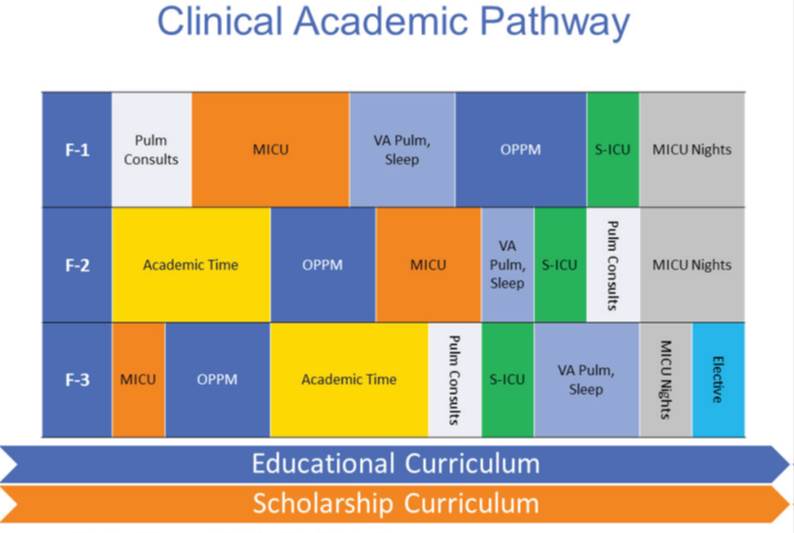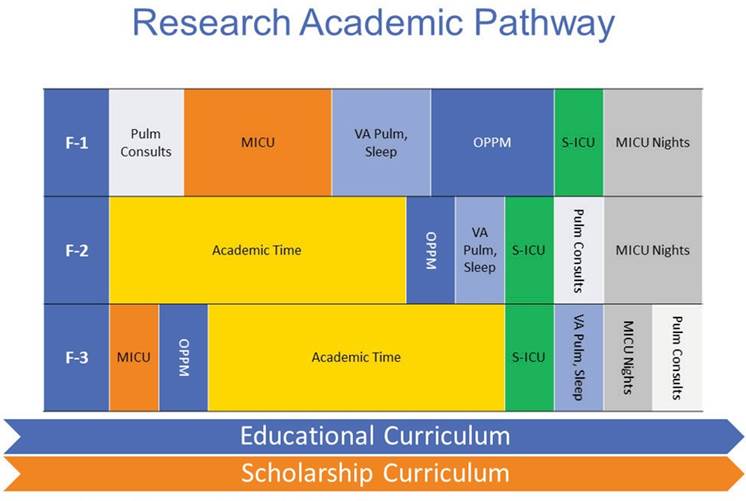Wake Forest School of Medicine
Winston-Salem, NC
Program Director: Edward Haponik, MD
Program Type: Pulmonary and Critical Care Medicine
Abstract Authors: Matthew C Miles, MD, and Edward F Haponik, MD
BACKGROUND
Within the fellowship program requirements of the ACGME, there are few specific mandates on how scholarly experiences must be structured. In years past, our fellowship program utilized one training template for all fellows. Over the past ten years, 65% of our graduates entered non-academic clinical practice. Of the 35% who entered academic positions upon graduation, 82% were appointed to positions with the expectation of scholarly productivity. Recognizing the varied careers chosen by our graduates, we sought to redesign our fellowship schedule to provide greater matching of a fellow’s career goals and interests with their fellowship experience, and to simultaneously increase the strength of faculty mentorship for career development.
METHODS
Beginning in July 2013 our training program established a fellow research committee composed of five academic faculty with current research funding. The role of this committee is to oversee the management of each fellow’s scholarly experience during fellowship in a model we have named Academic Pathways (Figures 1 and 2). Meeting quarterly, the committee reviews proposed, ongoing, and recently completed projects with a focus on increasing the fellows’ success in their stated career goals. The committee also acts to facilitate productive mentor/mentee interactions.
During the fall of the F-1 year, each fellow participates in a department-wide seminar on foundational research skills. At the end of this seminar, our division holds a Faculty Research Fair where areas of each faculty member’s scholarly interest are displayed and discussed. After discussing areas of career and research interest with a potential mentor, the F-1 fellow submits a project idea in January. After review and feedback from the faculty research committee, the fellow and mentor prepare a formal project proposal for the F-2 year. During the F-2 and F-3 years, individual fellows’ academic time may vary significantly. From a total of six months academic time in our Clinical Academic Pathway to as many as eighteen months in our Research Academic Pathway, quarterly reports on progress and evolving career goals help fellows remain task-oriented and personally invested in their ongoing projects. Furthermore, the academic pathway structure is flexible, allowing fellows to move from one pathway to another based on their evolving career goals and research interests. A longitudinal didactic curriculum in PCCM provides additional framework throughout the duration of training.
RESULTS
Key measures of success of our model include both tangible and intangible elements. Increased engagement of all faculty in fellow academic pursuits is not easily measured but contributes to a more exciting training environment for all. We continue to collect data on the number and quality of scholarly products generated by fellows and faculty and the ultimate career types chosen by fellows.
CONCLUSIONS
Over the last two years our program has implemented a flexible model of fellowship structure using a faculty research committee to tailor each fellow’s evolving academic pursuits. Our structure provides a robust scholarly experience for fellows and promotes increased faculty engagement with fellow research activities through multiple levels of mentorship. We believe this model could be adapted for use at many other training sites desiring a new fellow-centered model of academic productivity.

Figure 1. Wake Forest Clinical Academic Pathway Model. The usual Clinical Academic Pathway provides for six months’ protected time during the 36-month fellowship. MICU = Medical Intensive
Care Unit, VA = Veteran’s Affairs, OPPM = Outpatient Pulmonary Medicine, S-ICU = Surgical Intensive Care Unit

Figure 2. Wake Forest Research Academic Pathway Model. The usual Research Academic Pathway provides for twelve months’ protected time during the 36-month fellowship. Up to 18 months’ protected time can be arranged. MICU = Medical Intensive Care Unit, VA = Veteran’s Affairs, OPPM = Outpatient Pulmonary Medicine, S-ICU = Surgical Intensive Care Unit



